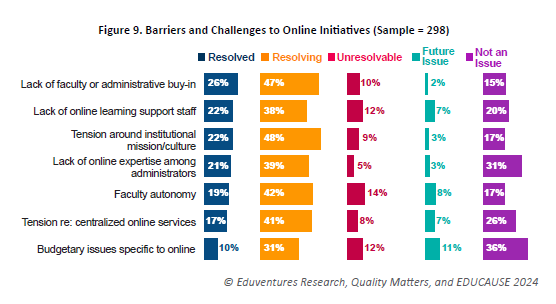You have /5 articles left.
Sign up for a free account or log in.

More students than ever are seeking online courses, but it has brought tension among faculty and administrators when it comes to teaching those courses.
monsitj/iStock/Getty Images Plus/Getty Images
Students are demanding more online courses than ever, a new survey of colleges’ chief learning officer finds, but this is accompanied by tensions over faculty autonomy and budget challenges.
According to the ninth annual “Changing Landscape of Online Education” (CHLOE) report, released today, roughly three-quarters of the chief learning officers polled reported an increasing demand for online options from campus-based students, with 60 percent noting that online sections typically fill first. Nearly half (46 percent) of the 324 online learning leaders surveyed added that online program enrollment is outpacing enrollment growth in on-campus programs at their institutions.
The findings come alongside seven in 10 respondents stating they are actively negotiating or had previously resolved tensions between online initiatives and the institution’s mission and culture. Roughly half of institutions say their institutions are currently addressing a lack of faculty or administrative buy-in to online initiatives, with another quarter adding they had similar problems that are now resolved. This is the first time the CHLOE report has asked respondents about cultural and attitudinal obstacles at their institutions.
About 4 in 10 (42 percent) state they are currently addressing concerns with faculty autonomy, which Bethany Simunich, vice president of innovation and research at Quality Matters, says center on both creating online course materials and teaching online courses.
“A lot of the tensions that I’m hearing about now are faculty saying, ‘Well, I want additional compensation for this,’” she said. “Or faculty fears if a subject matter expert comes in to design these courses at a cost savings, ‘What does that mean for me as a faculty member? What does that mean for my job? What does that mean for my identity? Am I always going to be teaching courses that somebody else designed?’”

A report from Quality Matters, Eduventures Research and Educause found tensions previously or currently exist among faculty and administrators over online programs.
Quality Matters, Eduventures Research, Educause
The report polled chief online officers at higher education institutions in January and February and focuses on the state of online and hybrid learning in higher education. The ninth annual report was conducted by Quality Matters, Educause and Eduventures Research, a division of Encoura, a data science and analytics platform. This is the first year Educause, a nonprofit focused on education and information technology, has joined as a full partner.
Simunich said while she typically hears frustrations from administrators about online enrollment outpacing on-campus enrollment, one of the biggest takeaways from the latest CHLOE report shows institutions are now more likely to be incorporating online programming into their institutional strategies.
Of the colleges that had a mix of online and on-campus students, roughly one-third of them (32 percent) said they had fully incorporated online learning into their strategy, with nearly half (48 percent) of those institutions being public two-year institutions.
A quarter are still examining “how online goals will be reflected in our strategy.” Another quarter (24 percent) said their online learning strategy only emphasizes specific student groups; online learning officers at private four-year institutions made up nearly four in 10 of the respondents who answered that way. About one in eight respondents said their institution has “no clear goals,” but that online learning is “under discussion.”
The remainder of respondents (39 percent) reported that either online learning goals have been formulated but not integrated at the institutional level, or that formulating online learning goals was a topic still under discussion. Public two-year institutions were most—and private four-year institutions least—likely to report institution-wide strategic integration of online programs.
Richard Garrett, chief research officer at Eduventures Research, said he found it “both a surprise and not a surprise” that tuition costs for online programs—which are typically similarly priced as on-campus programs—remained relatively stagnant.
According to the report, most institutions charge a uniform tuition regardless of modality, with just 15 percent charging less tuition for online delivery and 13 percent charging more. That has remained largely unchanged from similar numbers in past reports, according to Garrett.
“Given higher education has a cost problem—real and perceived—can we not leverage online technology and then pass that [savings] on to the consumer?” he said. “In one way I didn’t expect a big change, but with all the COVID pressure, having to do more with less and yet we still seem to be in a ‘play it safe’ mode, that doesn’t feel [like] where we should be, given our experiences.”
While the cost may remain relatively unchanged, a majority of institutions (69 percent) stated introducing online versions of on-campus courses was a priority, with nearly half of respondents (48 percent) expressing interest in developing new online degree programs and nondegree offerings, such as certificate programs or microcredentials.
Those priorities could be spurred in part by institutions’ attempts to reach new students as many fear an enrollment drop in the coming years. Nearly all institutions (92 percent) either “agreed” or “strongly agreed” that online offerings facilitate outreach to students within their region, with a similar proportion (87 percent) adding it facilitates outreach beyond their region.
Most (78 percent) are primarily focused on new and returning adult undergraduates in online courses, followed by 40 percent targeting traditional aged, on-campus students. One-third of institutions cited adult undergraduates using online courses to attain certificates or microcredentials as a “vital focus.”
Further takeaways in the report include:
- A small proportion of institutions (15 percent) work with online program managers (OPMs), with more than half (52 percent) stating they never had and had no plans to. There have been several concerns in the last year over looming legislation and some OPM giants experiencing financial stumbles. Of those working with OPMs, one-third said they had no plans to change the relationship, with 15 percent considering exiting the OPM relationship and 10 percent considering expanding the relationship.
- More than one-third (34 percent) of online learning officers said students are encouraged to use artificial intelligence (AI) to support learning, with 32 percent utilizing it to generate content, followed by developing or editing code (29 percent) and using AI-powered adaptive learning tools (27 percent).
- 42 percent of respondents saw “at least some” increase in their online learning budget, with similar numbers (41 percent) saying budgets are flat.
Garrett said as the report nears its 10th year, the sector could expect a potential peak in online course enrollment that will largely be dictated by the economy in the coming year.
“I think we might find that coming out of COVID, and if we move into a recession, online might go through another boom,” he said. “If we don’t, and sustain low unemployment, [and more] degree alternatives, more institutions might find that online isn’t the sort of emergency, ‘we need some quick enrollments’ button they can always press. They may start to find that it’s not working anymore.”









